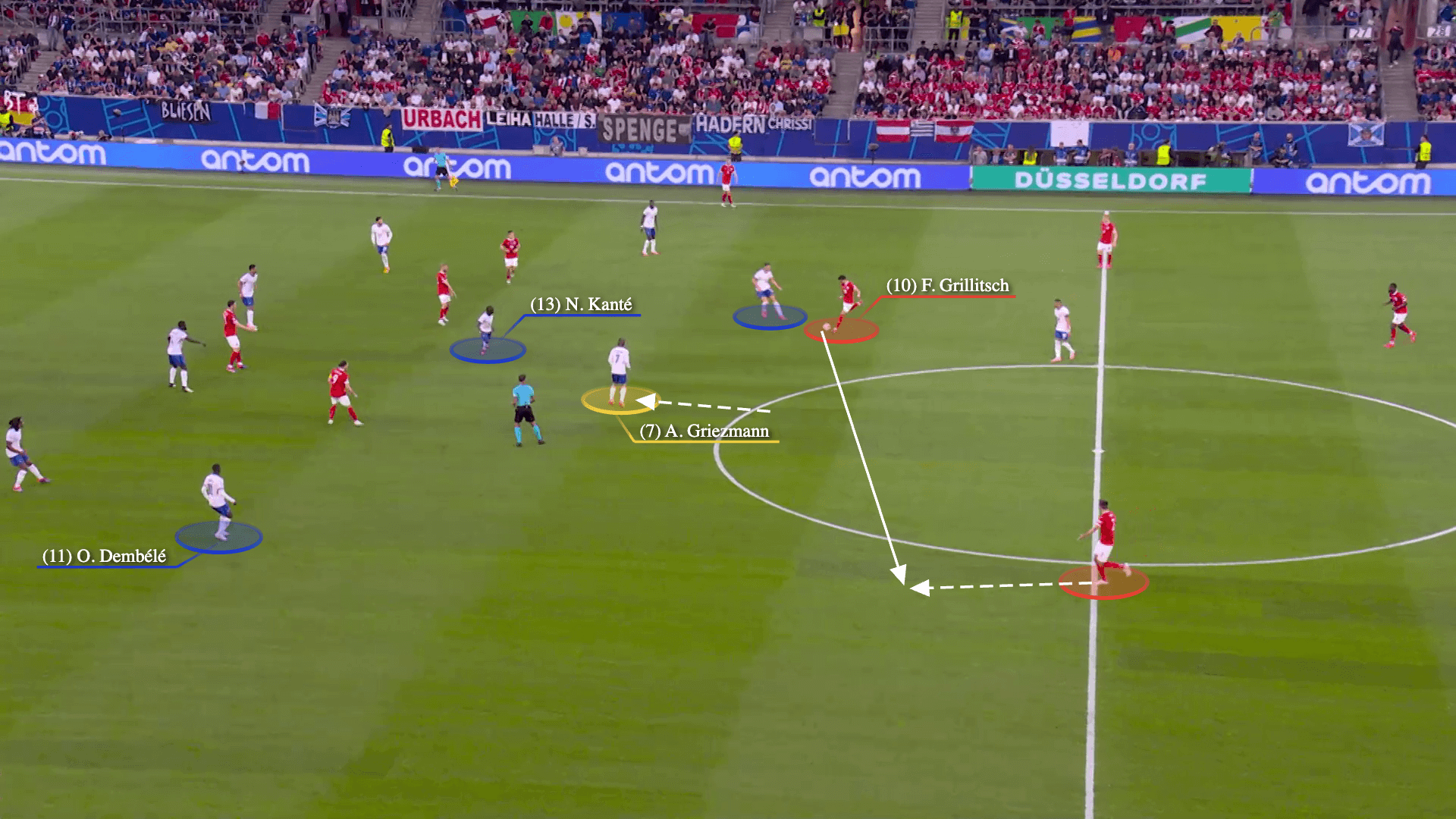When Didier Deschamps was asked a question about the pairing of N’Golo Kante and Adrien Rabiot in midfield after France’s 1-0 victory against Austria, he politely interrupted it to make a small correction.
“There were three of them,” said France’s manager. The third player was Antoine Griezmann, who has changed his role with the national team since the 2022 World Cup.
Advertisement
France’s switch to a midfield three featuring the Atletico Madrid forward has continued throughout the European Championship qualifying campaign and into the tournament, but they slightly adjusted their shape off the ball in their opening game against Ralf Rangnick’s Austria.
Usually, France’s 4-3-3 moves to a lopsided 4-4-2 when they are out of possession, with Kylian Mbappe maintaining a high position, while the right winger drops deeper to form a midfield four and the left midfielder is tasked with defending the flank. This way, Deschamps frees Mbappe of any defensive responsibilities and keeps him in an advanced position to be a threat on the transition.

Against Austria, Mbappe started on the left wing and rotated positions with Marcus Thuram when France had the ball. When they were without it, Mbappe was the most advanced player, with Thuram defending the left.
The switch altered France’s defensive shape, which oscillated between a 4-4-1-1 and a 4-5-1 — depending on Griezmann’s positioning — instead of the lopsided 4-4-2, with Mbappe closer to the centre-forward than the midfield line.

The logic behind this adjustment made sense. Austria’s approach on the ball mainly focuses on using their advanced full-backs (highlighted yellow) and the narrow front four — either by finding the forwards directly so they can combine or using the full-backs to access the No 10s in the half-spaces.

To create better passing angles for the four players building Austria’s attack, one member of the double pivot drops to form a 3-1 build-up shape, but France’s reactive approach without the ball, deeper block and threat on attacking transitions meant Rangnick’s build-up players couldn’t be higher up the pitch without the fear of being countered.
Here, Austria’s full-backs, Phillipp Mwene and Stefan Posch, are providing the width when Nicolas Seiwald plays the ball to Florian Grillitsch…

… but France’s shape out of possession makes it harder to advance the ball — Ousmane Dembele is ready to drop and defend against Mwene (out of shot), the back four are narrow to pincer Austria’s players between the lines, while Rabiot, Griezmann and Kante are blocking the passing lanes into them.
Grillitsch’s only option is to go back to his left centre-back, Maximilian Wober.

In another example, it’s the same situation: Thuram is in position to defend the left wing in case Seiwald plays the pass to his right-back, Dembele (out of shot) is next to Jules Kounde to protect against Austria’s left-back, the back four are narrow, and Griezmann drops to help Kante and Rabiot block the passing lanes into Austria’s narrow front four.

The change in the defensive shape and the positioning of Mbappe out of possession halted Austria’s most common progression methods: Dembele and Thuram dropped to defend against the full-backs and the compact shape behind Mbappe didn’t allow Rangnick’s team to combine between the lines.
“The two outside attacking players, who made the effort in periods when we didn’t have the ball, allowed us to have a compact group,” Deschamps said after the game.

However, the elephant in the room here is the game state. Wober’s unfortunate own goal in the 38th minute meant France were more than happy to drop deeper and play on the counter, which considering the strength of their back four inside the penalty area and the threat of their forwards on transitions is a reasonable approach.
Advertisement
The existence of this elephant comes from the fact France’s only goal of the game came out of nowhere. Deschamps’ side faced difficulties breaking down Austria’s pressing and only looked dangerous in transitional moments.
On the other hand, Christoph Baumgartner nearly put Austria in the lead from a transition in the other direction two minutes before Wober’s own goal. Considering Austria’s transitional threat and suitability to play from a leading game state, it’s interesting to see how Deschamps’ team would have reacted.
Mike Maignan’s save was just another example of the individual quality in his team. It’s important to remember how that factors in the analysis because without the back four’s incredible recovery runs on defensive transitions, Kante’s ball-winning ability in midfield, and Mbappe’s attacking prowess in space, the dynamic of the match changes.
Eventually, the tweak in France’s defensive shape worked and Rangnick’s team couldn’t create dangerous chances from settled possession — before and after the goal.
Will that approach work against stronger opponents with better individual qualities and diverse attacking ideas? The next games should provide us with some answers.

